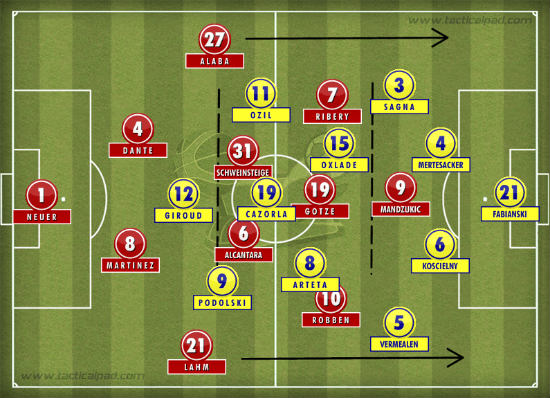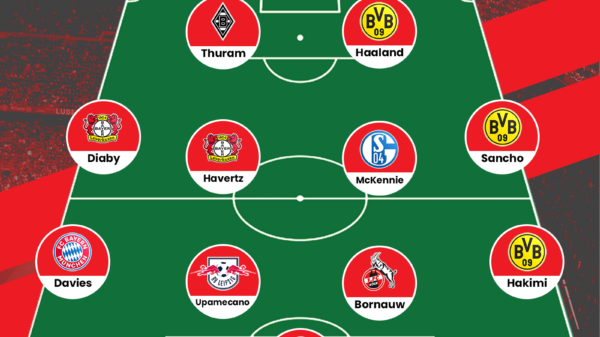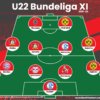Arsenal put in a commendable performance against Bayern Munich at the Emirates stadium, two weeks back, but came away with nothing and a difficult second leg at the Allianz Arena their only hope. They were buoyed by the fact that they emerged victorious there last season, but still found themselves knocked out.
The English side once again put in a stellar performance, which didn’t necessarily make them the better side, but did earn them the plaudits. For Bayern, it wasn’t their usual dominating performance but they were more deserving of the victory. They go through to the next round, full of confidence, and the title of ‘favourites’ still very much in tact.
Bayern dominated the first half with Arsenal restricted to a handful of counters. It was the home side that took the lead in the second half, with Bastian Schweingsteiger (who only just returned from injury) opening the scoring. Just three minutes later Lukas Podolski’ equalised with this fantastic narrow angle smasher. Bayern had the chance to seal it late on with a penalty, but for a second game in a row, the Germans failed to score from the spot with Mullers’ penalty saved by Fabianski, thus putting doubt over the usual belief of Germans and penalties.
Line Ups
Bayern Munich 1-1 Arsenal
Bayern Munich: Neuer, Lahm, Martinez, Dante, Alaba, Schweingsteiger, Thiago, Ribery (Muller 85′), Robben, Gotze (Kroos 59′), Mandzukic
Arsenal: Fabianski, Sagna, Vermealen, Koscielny, Mertesacker, Oxlade (Flamini 84′), Arteta (Gnabry 77′), Ozil (Rosicky 45′), Cazorla, Podolski, Giroud
Goals: Schweinsteiger 54′, Podolski 57′
Wenger’s poor first half approach
The Gunners came into the game knowing they needed to score atleast two goals to have any chance of remaining in the competition. It took the London side 30 minutes to take their first shot on goal; the entire first half was dominated by Bayern and it seemed unclear as to what Wenger’s strategy was. They largely depended on a deep defensive tactic, often seen with sides who are looking for a draw; a draw which would be a good result in the context of things. But knowing that Arsenal had to score, not going all out for the victory seemed a peculiar strategy.
Bayern were able to maintain a stronghold over the game, and while they found it difficult to get a meaninful shot off on goal, they seemed more than comfortable to go through to the quarters. They dominated possession, regained it quickly when lost and barely faced any trouble on their own goal.
Throughout the first half, Arsenal sat back and invited pressure on the defending Bundesliga and European champions. Was this in a bid to counter Bayern? Because that didn’t take place. Or was this an attempt to tire Bayern out for the second-half? A man of Wenger’s experience and intelligence wouldn’t attempt such a scenario. It left viewers wondering what Wenger had in mind for his side. It’s difficult to take control against Bayern, but not making a genuine attempt at it seemed strange. Did Wenger over think his tactics and go for an excessively defensive tactic to prevent conceding again? But at the cost of not scoring either?
What Arsenal did do successfully though, was the way they ‘clogged’ the midfield area to prevent the usual effect the Germans have on opponents. They didn’t press opponents higher up the pitch, inviting them into their own half but they formed a fairly solid midfield and defensive line in their own half. They made it tight in the middle and prevented direct creativity to the centre, forcing the ball wide (more on that later).
Olivier Giroud was the only real presser, which was a bit more adventurous than their first leg tactic. It can be seen in the picture above how the midfield lined up and prevented balls to be played straight through the centre. It still allowed Bayern a fair amount of possession, but they weren’t able to create meaningful chances. With players like Thiago Alcantara in the midfield, reducing the creativity from that area was vital. Thiago has a tendency of going forward, rather than sitting deep; this is in tandem with Bayern’s preference for short passing. This is what Wenger’s tactics looked to nullify. Effective but one will remain critical over the lack of attacking from the start.
The only meaningful attacking outlet was provided by Oxlade-Chamberlain, in particular a fantastic run midway through the first half, earning Arsenal a free-kick.
…and corrections made in the second
The second half was a complete contrast to Arsenal’s first half performance. What the side should have done from the start, go all-out for the victory or atleast make a decent case of it, was implemented from the second. And the effect it had on the German side was evident. Bayern’s dominance lies both in their ability, and lack of opponents’ ability. But Arsenal are a strong side. The game opened up more when Arsenal decided to go for a goal, rather than sit back.
It naturally pegged Bayern back as they realised the threat Arsenal created by pushing forward and getting numbers in.
As the illustration above shows, Arsenal came out with a better strategy in the second 45. More numbers got forward as the Gunners looked to press the man on the ball and have a cover over as well. Besides obviously enhancing Arsenal’s chances of retrieving possession and lessening the effect on their defence, it stretched Bayern’s play medially and prevented their usual short passing game.
Thus Arsenal’s second half showing again was impressive. Despite going out, they can be proud of their efforts over the two legs as they even remain unbeaten at Allianz Arena in two visits. They had a man sent off early in the first leg so the result was difficult, they matched Bayern stride for stride in the second half of the second leg but they need to be blamed for their poor first half.
Bayern forced to use the wide areas as Arsenal contain the wingers but struggle against the full-backs
As explained earlier, Arsenal clogged the midfield area forcing Bayern into wide areas and playing off the flanks. While the midfield tried to contain the creativity from the central regions, the full-backs sat back and attempted to contain the wingers. But once the Bayern full-backs got forward, there was not much the Arsenal players could do to prevent them from having a telling contribution on the game.
MORE READING | Arsenal 0-2 Bayern Munich: Tactical Analysis
The Arsenal midfield didn’t do enough to counter the attack of the full-backs as the Germans exploited the flanks. The movement of Ribery and Robben was difficult to defend against as well, with often the Arsenal full-backs preventing them from dribbling forward, but not doing enough to contain them when they found space on the flanks as a passing outlet. To put it plainly, the wingers weren’t able to advance with the ball forward, but took possession anyway in wide areas with their movement.
It proved to be the primary attacking option for Bayern, which isn’t the case usually. Credit to Arsenal for preventing their main attacking strategy as the one that was forced upon them wasn’t as effective. They had a huge 31 attempted crosses, but were successful at finding a team-mate in only 5 of them.
Give that Bayern struggled to cement themselves when forced to deviate from Plan A, questions will be raised over their capabilities in the Champions League. Keep an eye out for their odds at http://www.888sport.com over the next few weeks as the Champions League reaches the penultimate stages.
Bayern fail to get enough men in the box
What made the wide system even more frail was the fact that Bayern didn’t have enough men forward for the crosses to be aimed into. Neither of Robben or Ribery got into the box as they were contained while the midfield, as explained, was involved in a battle in the centre. Mandzukic was up alone or even this was often lacking.
Thiago and Schweinsteiger were always going to be sitting deep, rarely making it all the way into the box, but Gotze (as he did in the first leg) was expected to make runs in to support Muller. The youngster too though was marked out of the game. Arsenal were thus able to deal with any attack coming in from the wide areas, simply due to the superior numbers back in the box.
Having said that, one rare moment where Bayern did have a midfield man making a run into the box, it resulted in a goal. Schweinsteiger made a late run into the box which went complete unnoticed. It was the defenders duty to pick up his run but a lack of concentration allowed the midfielder in.
Arsenal thus succeeded in reducing the penetration into their own box both by narrowing Bayern’s system and preventing those short passes from leaking in. Here’s where Bayern probably differ from Barcelona. The Spanish side have the likes of Messi & Neymar who will continue to play through the centre, they’re less easily forced wide as compared to Bayern Munich.
Where does this leave them?
Bayern Munich look set to challenge for another treble going into the final part of the season. They also look the strongest side yet to be the first ever to retain their Champions League crown. Their dominance has been pulled into question, failing to beat two of the biggest sides they’ve faced at home, Man City and Arsenal. While some may be making it a full-gone conclusion, complacency can still be a concern. It’s always difficult to predict the Champions League, but over two legs you’d have to favour Bayern against most sides.
Arsenal on the other hand, despite the defeat, can still be confident of ending their trophy drought. Having reached the FA Cup semi finals, they remain the favourites to take home the crown. But their Champions League run is quesitonable again, facing Bayern twice in a row is purely bad luck but the fact state that they’ve been knocked out at this stage for four consecutive season. They can definitely be proud of last season’s result and the Bayern Munich 1-1 Arsenal result from this season. No doubt they’ll be in the competition again, but a Round of 16 spot, season after season, isn’t good enough.
Click here to read all our other Tactical Analysis pieces.






























































